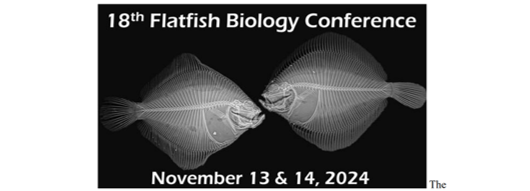Check out the SNEC Winter 2024 Newsletter here!
| SNEC Newsletter 2024-03-25 Winter Meeting Recap Member Submitted Content Save the Date, 18th Flatfish Biology Conference Sea Grant and NOAA Fisheries Announce 2023 Joint Fellowship Program Awardees Recently Published Research The Structures of the Demersal Fish Communities of New Bedford and Gloucester Harbors, Two Massachusetts Urban Estuaries Winter Meeting Recap The SNEC 2024 Winter Science Meeting happened on 9 January at the University of Connecticut in Storrs. The program kicked off with a welcome by President Corinne Truesdale, who took the time to describe for the benefit of new members what the American Fisheries Society is all about, how the Southern New England Chapter fits into the organization, and how people can get involved with the chapter. We hope that you will take a moment to view her presentation here. Following her welcome, attendees heard from 18 captivating presenters, covering studies of behavior, physiology, population biology, genetics, conservation, sampling methods, and of course fisheries management, of freshwater and marine fish as well as invertebrates! Eight of the presenters were students. The program is available here, and it includes abstracts and contact information for the presenters; if you couldn’t make it to the meeting and want to see a presentation, just ask the presenter; they were all recorded! Sponsors for the meeting included the Connecticut Department of Energy and Environmental Protection, the School for Marine Science and Technology at UMass Dartmouth, Connecticut Sea Grant, UConn’s Department of Natural Resources and the Environment, and UConn’s Department of Ecology and Environmental Biology. We are quite grateful to them as it enables us to have the meetings at nice locations and to offer amenities such as a nourishing and tasty lunch from Moe’s Southwest Grill, a break that at which we served UConn’s famous Dairy Bar Ice Cream, and a reception afterwards at the Trophy Room of the Graduate Hotel. We had a terrific turnout of 96 people, of which 28 were students. We hope you could make it this time, and of course we can look forward to summer! The date and location are to be determined but it’s Rhode Island’s turn, as we finish up the term of President Truesdale and welcome the term of President Archer. Member Submitted Content Save the Date, 18th Flatfish Biology Conference, November 13th and 14th The Flatfish Biology Conference welcomes talks and poster presentations addressing any aspect of flatfish research (e.g., biology, ecology, aquaculture, stock assessment, physiology, etc.) from all regions. Professional and student flatfish researchers are invited to participate. For more information, please visit our website or contact the conference co-chairs: Steve Dwyer, [email protected] Elizabeth Fairchild, [email protected] Renee Mercaldo-Allen, [email protected] Sea Grant and NOAA Fisheries Announce 2023 Joint Fellowship Program Awardees Sea Grant and NOAA Fisheries are pleased to announce the 2023 National Marine Fisheries Service (NMFS)-Sea Grant Joint Fellowship recipients. Seven population and ecosystem dynamics fellowships and one marine resource economics fellowship will be awarded through this national program. To read the full story click here… Recently Published Research The Structures of the Demersal Fish Communities of New Bedford and Gloucester Harbors, Two Massachusetts Urban Estuaries Geoghegan Paul, Michael D. Murphy, and Anthony R. Wilbur. 2023, Northeastern Naturalist. We sampled the inshore fish communities of New Bedford and Gloucester harbors synoptically using identical gear for 12 months during 1998–1999. Although the 2 harbors are only 110 km apart, they are separated by Cape Cod, which is the transition between the southern New England (New Bedford) and the Gulf of Maine (Gloucester) biogeographic regions. The 2 fish communities were 69% dissimilar from each other using the Bray–Curtis dissimilarity index (B–C). Stenotomus chrysops (Scup) composed 80% of the catch in New Bedford Harbor, did not occur in Gloucester Harbor, and contributed 7.40% to the total dissimilarity between the harbors. B–C identified 2 seasonal groups in the New Bedford Harbor fish community: May–October and November–April. Leucoraja spp. (skates) comprised the most numerous taxon captured in Gloucester Harbor, accounting for 24.90% of the total catch followed by Pseudopleuronectes americanus (Winter Flounder; 24.16%), and Gadus morhua (Atlantic Cod; 22.52%). These taxa contributed 7.23%, 3.88%, and 6.16% respectively to the total dissimilarity between harbors. B–C identified 4 seasonal groups in Gloucester Harbor: January, February and March, April and May, and June–December. These data provide an important description of the fish communities in the 2 harbors in different biogeographic regions at the end of the 20th century. We expect differences between the communities to decrease with increasing water temperature due to climate change. Read the full paper.. SNEC exists to encourage exchange of information by members of the American Fisheries Society residing or working within Massachusetts, Connecticut, and Rhode Island. Find us online: Website Facebook Twitter | X YouTube Submit your own newsletter content here |

